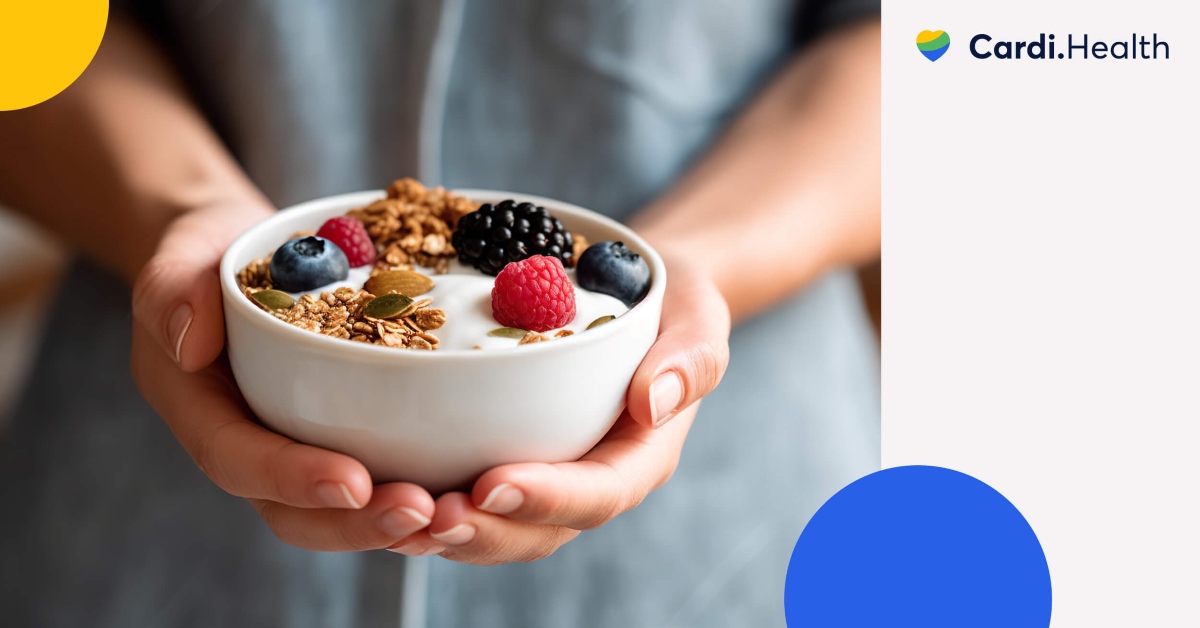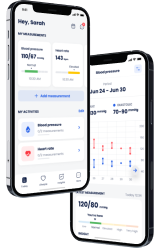When it comes to managing hypertension, maintaining a healthy diet is crucial since certain foods can elevate your blood pressure.
The DASH diet is widely recognized for its health benefits, effective weight loss support, and ability to successfully manage high blood pressure, as it focuses on hypertension-friendly food groups and healthy eating.
In this article, we will delve into the essential aspects of this diet, explore its impact on blood pressure control, and discuss its overall positive effects on your health.

Master your heart health now
Take part in our 60sec quiz and get a heart health plan tailored just for you.
Contents
Understanding the DASH Diet
DASH stands for Dietary Approaches to Stop Hypertension, and it’s been praised by the American Heart Association (AHA) as well as the National Heart, Lung, and Blood Institute (NHLBI).
The main goal of this diet is to lower the amount of sodium you consume and to focus on eating foods that are better for people with high blood pressure.
The Key Principles of the DASH Diet
Let’s explore the key aspects of the DASH eating plan that make it effective in managing hypertension and improving overall health. By following these principles, you can introduce constructive modifications to your dietary habits and improve your well-being.

Emphasizing fruits and vegetables
The DASH diet emphasizes fruits and vegetables as one of the most important ingredients.
In fact, it is recommended that you eat at least 4–5 servings a day. The reason for such a focus on these foods is that they are great at lowering high blood pressure.
One study showed that people with high blood pressure who followed a meal plan rich in fruits and vegetables reduced their systolic and diastolic blood pressure.
Whole grains for a heart-healthy diet
Another ingredient that the DASH diet focuses on is whole grains.
They are a great help in maintaining normal blood pressure because they are rich in potassium, which helps lower blood pressure. In addition, eating whole grains can help improve blood cholesterol levels and lower your risk of stroke and obesity.
Including whole-grain options such as bread, whole-grain pasta, brown rice, and oatmeal in your meals is a smart way to adopt a heart-healthy eating habit and prioritize your cardiovascular well-being.
Lean proteins for optimal health
Including lean protein in your diet is important not only for the DASH diet but also for maintaining overall health.
Poultry and fish are excellent sources of lean protein, packed with essential vitamins and minerals. Legumes, on the other hand, provide a combination of dietary fiber and plant-based protein.
Choosing low-fat or fat-free dairy products, such as yogurt and skim milk, provides protein and calcium for strong bones.
By incorporating these lean protein foods into your meals, you not only support muscle building but also experience a greater sense of satiety, which ultimately contributes to a balanced and nutritious diet.
Start managing your heart health now!
Find out what works for you with this 60sec quiz.

Healthy fats for heart health
When considering dietary fats, it’s crucial to distinguish between those that should be avoided and those that are actually beneficial for heart health.
As a rule of thumb, try to steer clear of foods that have saturated fat, such as fatty meats, full-fat dairy products, tropical oils, and similar, as saturated fat can raise “bad” LDL cholesterol and increase the risk of heart disease and stroke.
At the same time, adding healthy fats to your diet can improve blood cholesterol levels, stabilize heart rhythm, and help treat high blood pressure. Excellent sources of healthy fats include nuts such as almonds, walnuts, and pistachios, as well as olive oil and avocados.
Reducing sodium intake
Reducing sodium intake is a key principle of the DASH diet.
Too much sodium can raise blood pressure, which increases the risk of heart disease and other health issues. To reduce salt intake, it is essential to be mindful of the amount added to meals during cooking and at the table.
Go for fresh, whole foods and minimize processed and packaged foods, as these often contain high sodium levels. Reading food labels and choosing low-sodium or sodium-free alternatives can also make a big difference.
Implementing the DASH Diet in Daily Life

Now that we know the main principles of this heart-healthy diet let’s discuss how you can implement it into your daily life.
Meal planning and preparation
Planning and preparing your meals can make it easier to follow the DASH diet. Here are some tips to help you out:
- Take time each week to plan what you’ll eat.
- Avoid using foods that contain a lot of sodium.
- Try recipes that are DASH diet-friendly.
- When shopping, make a list of the foods you need for those recipes and stick to it.
Get professional help
Getting professional help can be beneficial when following the DASH diet, especially if you have specific health concerns or need guidance tailored to your needs.
One resource that can provide great support is Cardi Health, an application designed to help individuals manage their heart health. Cardi Health offers personalized nutrition guidance, including a DASH diet-friendly eating plan, to help you make informed choices and stay on track.
With its user-friendly interface and expert-backed information, Cardi Health facilitates a comprehensive understanding of a healthy diet, helps you track your progress, and provides access to valuable resources.
By taking advantage of the features and insights offered by Cardi Health, you can confidently navigate your journey and optimize your overall well-being.
Start managing your heart health now!
Find out what works for you with this 60sec quiz.

Think smart when eating out
Making healthier choices when dining out can be challenging, but there are a few tips that can come in handy:
- Research restaurants ahead of time to find those with healthier options.
- Look for places that offer fresh, grilled, or steamed dishes instead of fried or heavily processed ones.
- Ask for modifications, such as having dressings or sauces on the side or substituting sides with steamed vegetables.
- Focus on dishes that include lean proteins, plenty of vegetables, and whole grains.
- Avoid dishes that are high in sodium or come with heavy sauces.
- Be mindful of portion sizes and consider sharing a dish or taking leftovers home.
The Benefits of the DASH Diet

Now that we’ve uncovered the key elements of the DASH diet eating plan and discovered practical ways to incorporate it into your daily life let’s dive into its benefits.
Lowering blood pressure naturally
The diet’s focus on eating fruits, vegetables, whole grains, lean proteins, and low-fat dairy foods or fat-free dairy foods promotes a nutrient-rich eating plan that can naturally help lower your blood pressure.
One study suggests that the DASH diet can not only reduce blood pressure naturally but also prevent or delay the need for hypertension medication. Another study by the National Heart, Lung, and Blood Institute says that combining this diet with low salt intake lowers blood pressure more than the typical American diet.
Reducing the risk of heart disease
Due to its heart-healthy ingredients, the DASH diet can significantly reduce the risk of heart disease. A study published in the Journal of the American College of Cardiology revealed that following the diet was associated with a lower risk of developing heart disease, including heart attacks and strokes.
Another study shows that this diet significantly reduces the levels of LDL cholesterol, which is known to contribute to heart disease.
Managing weight and promoting weight loss
The DASH diet can also help you lose weight and manage it long-term. It focuses on fruits, vegetables, whole grains, lean proteins like chicken or fish, and fat-free dairy products, which have important nutrients but are not very high in calories.
The DASH diet also teaches you to pay attention to how much you eat. This means you think about the size of your portions and follow your body’s signals that it’s full. By eating the right amount and choosing healthy foods, you can lose weight and keep it off for good.
Improving insulin sensitivity
Studies have found that the DASH diet can improve insulin sensitivity and better glucose control. The diet focuses on eating foods that have lots of blood pressure-lowering nutrients and reduce the chances of getting type 2 diabetes. If you already have type 2 diabetes, this diet, as well as the Mediterranean diet, can help you manage your blood sugar levels better.
Supporting brain health
The diet also supports brain health and cognitive function. Its focus on nutrient-rich foods provides essential vitamins, minerals, and antioxidants that are important for brain health. Studies only confirm that following the DASH diet may have potential benefits for maintaining a healthy brain and reducing the risk of cognitive decline.
Boosting energy levels
The DASH diet provides your body with essential nutrients that support optimal energy production. These foods are rich in vitamins, minerals, and fiber, which are important for maintaining steady energy levels throughout the day. Adequate nutrient intake is crucial for supporting your metabolism, which converts food into energy.
Tips for Long-Term Success

Staying motivated and following the DASH diet are important components of achieving your health goals. It’s especially valuable to find a support system of friends, family, or even an online community that can provide encouragement and hold you accountable. By surrounding yourself with people who are supportive and encouraging, you’ll find it easier to stay on track and committed to your DASH diet journey.
Another thing to remember is that regular exercise is a big part of being healthy – along with the DASH diet. Start small, like taking short walks, dancing to your favorite songs, or playing active games with your friends. Slowly build up and try to get at least 150 minutes of exercise each week – that’s what experts recommend. Combine this healthy diet with exercise, have people cheering you on, and you’ll be on your way to a healthier lifestyle in no time!
Start managing your heart health now!
Find out what works for you with this 60sec quiz.

FAQ
What does DASH stand for in the DASH diet?
DASH stands for Dietary Approaches to Stop Hypertension.
Why is the DASH diet recommended for people with high blood pressure?
The DASH diet aims to lower sodium intake and emphasizes foods beneficial for people with high blood pressure, such as fruits, vegetables, and whole grains.
What types of foods are emphasized in the DASH diet?
The DASH diet focuses on fruits, vegetables, whole grains, lean proteins, and low-fat dairy products.
How can the Cardi Health application assist with the DASH diet?
Cardi Health offers personalized nutrition guidance, DASH diet-friendly eating plans, and expert-backed information to help individuals manage their heart health.
The DASH Diet: Key Takeaways
DASH, which stands for Dietary Approaches to Stop Hypertension, focuses on eating foods like fruits, vegetables, whole grains, lean meats, and low-fat dairy products. This diet has a lot of health benefits, like lowering your blood pressure naturally and reducing the risk of heart disease by lowering cholesterol levels. It helps you with weight loss and its maintenance by teaching portion control and choosing nutritious foods. The DASH diet even supports brain health and provides sustained energy levels.
To make things easier for yourself, you can use tools such as the Cardi Health application that provides DASH diet-friendly recipes and will help you incorporate the DASH diet-related eating plan as a long-term, sustainable lifestyle change.
Related articles
Best Foods to Lower Cholesterol
Does Caffeine Raise Blood Pressure?
Does Drinking Water Lower Blood Pressure?
Causes of High Blood Pressure at Night
10 DASH Diet Breakfasts for a Healthy Start
Heart-Healthy Diet Guide
What Should an 85-Year-Old Blood Pressure Be?
What is Normal Blood Pressure for a 70-Year-Old?
How to Read Blood Pressure: A Comprehensive Guide
Manage your heart health now
Find out what works best for you with this 60sec quiz and get your personalized heart health plan.

